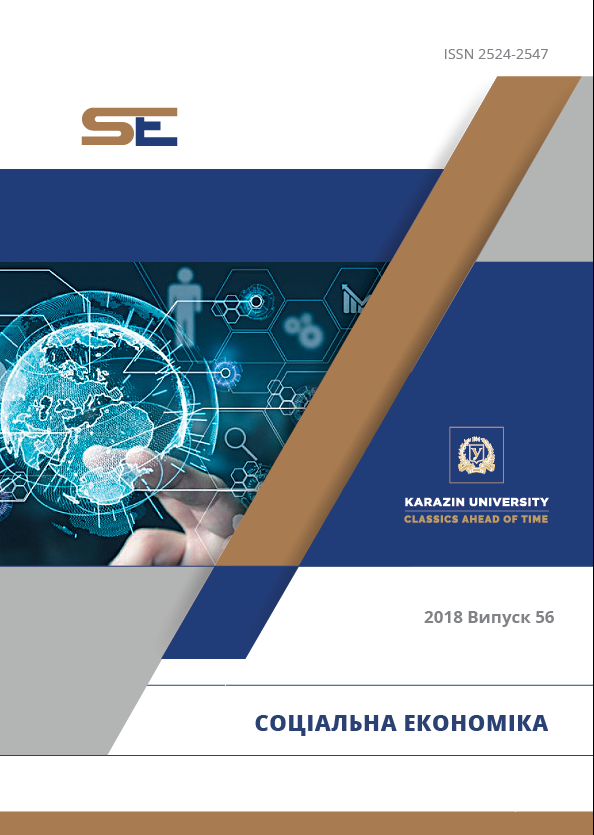Диференціація методів управління кадровим потенціалом підприємства
Анотація
Метою статті є визначення методів управління кадровим потенціалом підприємства, враховуючи ретроспективний характер потенціалу (набуті характеристики), поточний його стан та характеристики, майбутні здібності та можливості, які будуть необхідні задля сталого розвитку підприємства, а також формування авторського бачення системи управління кадровим потенціалом на підприємстві за стадіям та в розрізі функцій управління.
У ході дослідження виявлено, що управління кадровим потенціалом на підприємстві повинно починатися ще на стадії до встановлення офіційних трудових правовідносин «роботодавець-найманий працівник», бо майбутнього штатного працівника високої кваліфікації, який відноситься до кадрового потенціалу, необхідно відшукати та залучити до штату підприємства. Структуровано системи управління кадровим потенціалом на підприємстві в залежності від стадії управління (before employment, employment, after employment). Зміна самої праці, її перехід від традиційних форм до нетрадиційних, де переважають гнучкі структури, призводить до розширення поняття «співробітник компанії» та управління комбінованою робочою силою, коли для реалізації бізнесзавдань компанії залучають не тільки штатних співробітників, а й зовнішніх галузевих експертів. З’являється так званий out-ринок праці відносно підприємства, не тотожний зовнішньому ринку праці в повній мірі.
Представлено розширене бачення систематизації методів управління кадровим потенціалом на підприємстві за ознакою належності до функцій управління, додавши мотиваційні методи, адже мотивація є базовою функцією управління. Крім того, групування методів за характером змін у системі управління, яке передбачає виділення інноваційних методів, доповнено традиційними, адже, з плином часу, кожен інноваційний метод в міру свого поширення перетворюється на традиційний. Також введено дві класифікаційні ознаки, за якими доцільно групувати методи за фасеточним принципом: залежно від проявів потенціалу – методи out-управління (націлені на майбутній та минулий потенціал) та методи in-управління (націлені на теперішній потенціал).
Завантаження
Посилання
Shynkaruk, V. I. (2002). Philosophical encyclopedic dictionary [“Filosofskyi entsyklopedychnyi slovnyk”]. Kyiv: Abrys.
Strekhova, S. V. (2012). Interconnection and interdependence of elements of the personnel management system [“Vzaiemoziazok i vzaiemoobumovlenist elementiv systemy upravlinnia personalom”]. Aktualni problemy ekonomiky, 6(132), pp. 225‒233.
Kuzmin, O. Ye. and Melnyk, O. H. (2003). Fundamentals of Management [“Osnovy menedzhmentu”]. K.: Akademvydav.
Smachylo, V. V. (2017). Theoretical principles of structuring the personnel potential of the enterprise [“Teoretychni zasady strukturyzatsii kadrovoho potentsialu pidpryiemstva”]. Sotsialno-trudovi vidnosyny: teoriia ta praktyka: zb. nauk. Prats, 2(14), рp. 215‒225.
Kharun, O. A. (2016). Classification of methods for managing the labor potential of industrial enterprises [“Klasyfikatsiia metodiv upravlinnia trudovym potentsialom promyslovykh pidpryiemstv”]. [online] Available at: http://nbuv.gov.ua/UJRN/Nvuumevcg_2016_10%282%29_ _29 [Accessed 25 Nov. 2018].
Onyshchenko, E. (2012). Human Resources Management System: An Approach to Subsystem Design [“Systema upravlinnia kadrovym potentsialom pidpryiemstva: pidkhid do proektuvannia pidsystem”]. [online] Available at: http://visnykj.tneu.edu.ua/index.php/visnykj/article/view/408 [Accessed 24 Nov. 2018].
Korsakov, D. O. (2011). Organizational diagnostics of enterprise personnel management system. [“Orhanizatsiina diahnostyka systemy upravlinnia personalom pidpryiemstva”]. [online] Available at: http://www.ed.ksue.edu.ua/ER/RER/documents/blog.php?entry_id=1317157920 [Accessed 29 Nov. 2018].
Posheliuzhna, L. B. (2010). Features of modern personnel management at domestic enterprises [“Osoblyvosti suchasnoho upravlinnia personalom na vitchyznianykh pidpryiemstvakh”]. Innovative economy, 3, рр. 163‒166.
Lozynskyi, I. Ye. and Yelisieieva, L. O. (2012). Theoretical foundations of the personnel management system of the enterprise [“Teoretychni osnovy systemy upravlinnia personalom pidpryiemstva”]. Ekonomika i rehion, 3, pp. 184‒188.
Sardak, O. V. (2011). The position of marketing personnel in the management of employees of enterprises [“Pozytsiia personal-marketynhu v upravlinni pratsivnykamy pidpryiemstv”]. Ekonomichnyi analiz, 8, pp. 303‒307.
Rashytova, N. K. (2008). Methods and main functions of management activity [“Metody ta osnovni funktsii upravlinskoi diialnosti”]. Derzhavne budivnytstvo, 1. [online] Available at: http://nbuv.gov.ua/UJRN/DeBu_2008_1_8 [Accessed 25 Nov. 2018].
Lyzunova, O. M. and Ishchenko, Ya. H. (2018). Use of innovative methods of personnel management of the enterprise [“Vykorystannia innovatsiinykh metodiv upravlinnia personalom pidpryiemstva”]. Ekonomika i suspilstvo, 14. [online] Available at: http://economyandsociety.in.ua/ /journal/14_ukr/62.pdf [Accessed 29 Nov. 2018].
Ey.com. (2018). New Trends in Personnel Management: How to Build an Organization for the Future [“Novi trendy u sferi upravlinnia personalom: yak pobuduvaty orhanizatsiiu maibutnoho”]. [online] Available at: https://www.ey.com/ua/uk/newsroom/news-releases/news-ey-press-release-3-october-2018 [Accessed 25 Nov. 2018].
Smachylo, V. V. (2007). Regulation of working time as a component of non-material motivation [“Rehuliuvannia robochoho chasu yak skladova nemateryalnoi motyvatsii”]. Ukraina: aspekty pratsi, 8, pp. 49‒50.
Smachylo, V. V. (2017). Formation of personnel reserve of the enterprise as an element of social responsibility [“Formuvannia kadrovoho rezervu pidpryiemstva yak element sotsialnoi vidpovidalnosti”]. International Scientific and Practical Conference, pp. 113‒114.





